1994 PONTIAC GRAND-AM tire pressure
[x] Cancel search: tire pressurePage 206 of 274
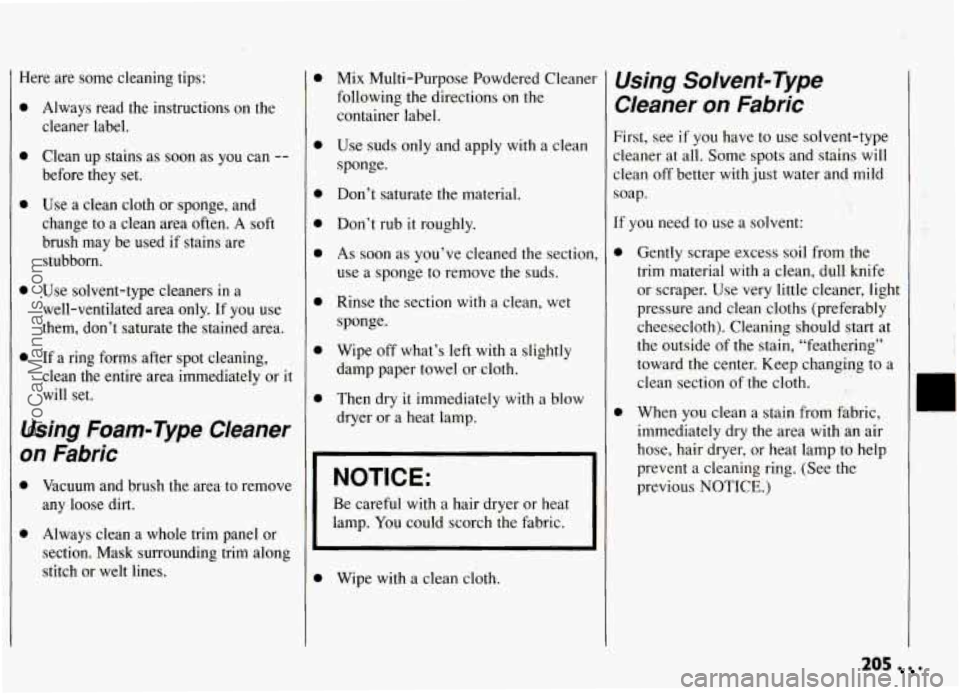
Here are some cleaning tips:
0
0
0
0
0
Always read the instructions on the
cleaner label.
Clean up stains as soon as you can
--
before they set.
Use a clean cloth or sponge, and
change to a clean area often. A soft
brush may be used if stains are
stubborn.
Use solvent-type cleaners in a
well-ventilated area only. If you use
them, don’t saturate the stained area.
If a ring forms after spot cleaning,
clean the entire area immediately or
it
will set.
Using Foam-Type Cleaner
on Fabric
0 Vacuum and brush the area to remove
any loose dirt.
0 Always clean a whole trim panel or
section. Mask surrounding trim along
stitch or welt lines.
0
0
0
0
0
0
0
0
Mix Multi-Purpose Powdered Cleaner
following .the directions on the
container label.
Use suds only and apply with a clean
sponge.
Don’t saturate the material.
Don’t rub
it roughly.
As soon as you’ve cleaned the section,
use a sponge to remove the suds.
Rinse
the section with a clean, wet
sponge.
Wipe off what’s left with a slightly
damp paper towel
or cloth.
Then dry it immediately with a blow
dryer or
a heat lamp.
NOTICE:
Be careful with a hair dryer or heat
lamp. You could scorch the fabric. ~
0 Wipe with a
clean cloth.
Using Solvent-Type
Cleaner on Fabric
First, see if you have to use solvent-type
cleaner at all. Some spots and stains will
clean off better
with just water and mild
soap.
If you need to use a solvent:
0
0
Gently scrape excess soil from the
trim material with a clean, dull knife
or scraper. Use very little cleaner, light
pressure and clean cloths (preferably
cheesecloth). Cleaning should start at
the outside
of the stain, “feathering”
toward the center. Keep changing to a
clean section of the cloth.
When you clean a stain from fabric,
immediately dry the area with an air
hose, hair dryer, or heat lamp to help
prevent a cleaning ring. (See the
previous NOTICE.)
205 .
ProCarManuals.com
Page 209 of 274
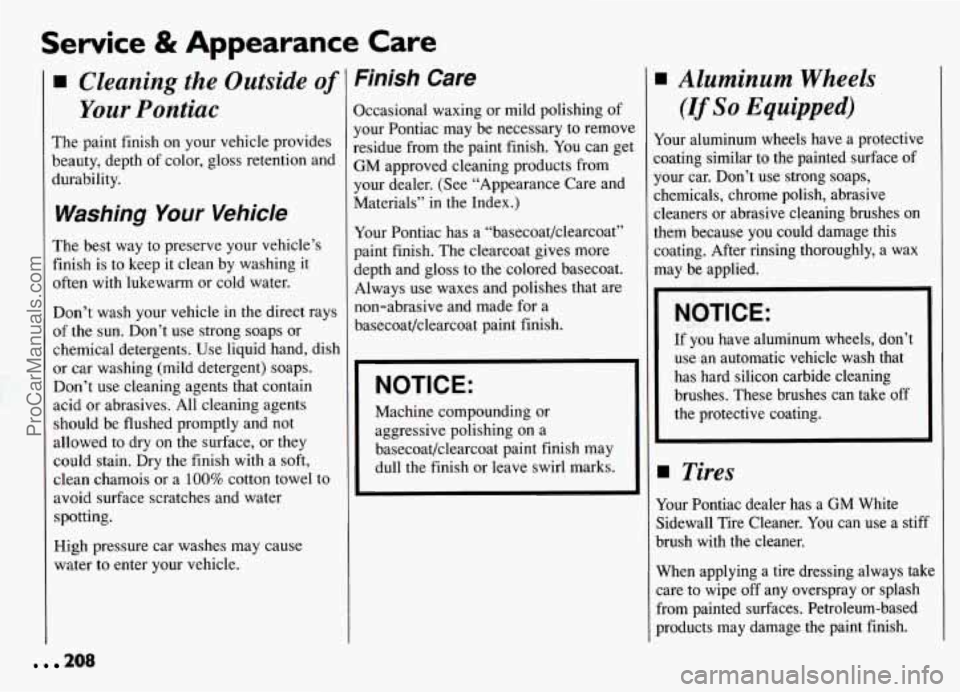
Service & Appearance Care
Cleaning the Outside of
Your Pontiac
The paint finish on your vehicle provides
beauty, depth of color, gloss retention and
durability.
Washing Your Vehicle
The best way to preserve your vehicle’s
finish is to keep it clean by washing it
often with ‘lukewarm or cold water.
Don’t wash your vehicle in the direct rays
of the sun. Don’t use strong soaps or
chemical detergents. Use liquid hand, dish
or car washing (mild detergent) soaps.
Don’t use cleaning agents that contain
acid or abrasives. All cleaning agents
should be flushed promptly and not
allowed to dry on the surface, or they
could stain. Dry the finish with a soft,
clean chamois or a 100% cotton towel to
avoid surface scratches and water
spotting.
High pressure car washes may cause
water to enter your vehicle.
Finish Care
Occasional waxing or mild polishing of
your Pontiac may be necessary to remove
residue from the paint finish. You can get
GM approved cleaning products from
your dealer. (See “Appearance Care and
Materials” in the Index.)
Your Pontiac has a “basecoat/clearcoat”
paint finish. The clearcoat gives more
depth and gloss to the colored basecoat.
Always use waxes and polishes that are
non-abrasive and made for a
basecoat/clearcoat paint finish.
NOTICE:
Machine compounding or
aggressive polishing on a
basecoat/clearcoat paint finish may
dull the finish or leave swirl marks.
I
’I
1
1
Aluminum Wheels
(If So Equipped)
Your aluminum wheels have a protective
:eating similar to the painted surface of
your car. Don’t use strong soaps,
zhernicals, chrome polish, abrasive
:leaners
or abrasive cleaning brushes on
them because you could damage this
coating. After rinsing thoroughly, a wax
may be applied.
NOTICE:
If you have aluminum wheels, don’t
use an automatic vehicle wash that
has hard silicon carbide cleaning brushes. These brushes can take
off
the protective coating.
Tires
Your Pontiac dealer has a GM White
Sidewall Tire Cleaner. You can use a stiff
brush with the cleaner.
When applying a tire dressing always take
care to wipe
off any overspray or splash
from painted surfaces. Petroleum-based
products may damage the paint finish.
208
ProCarManuals.com
Page 217 of 274
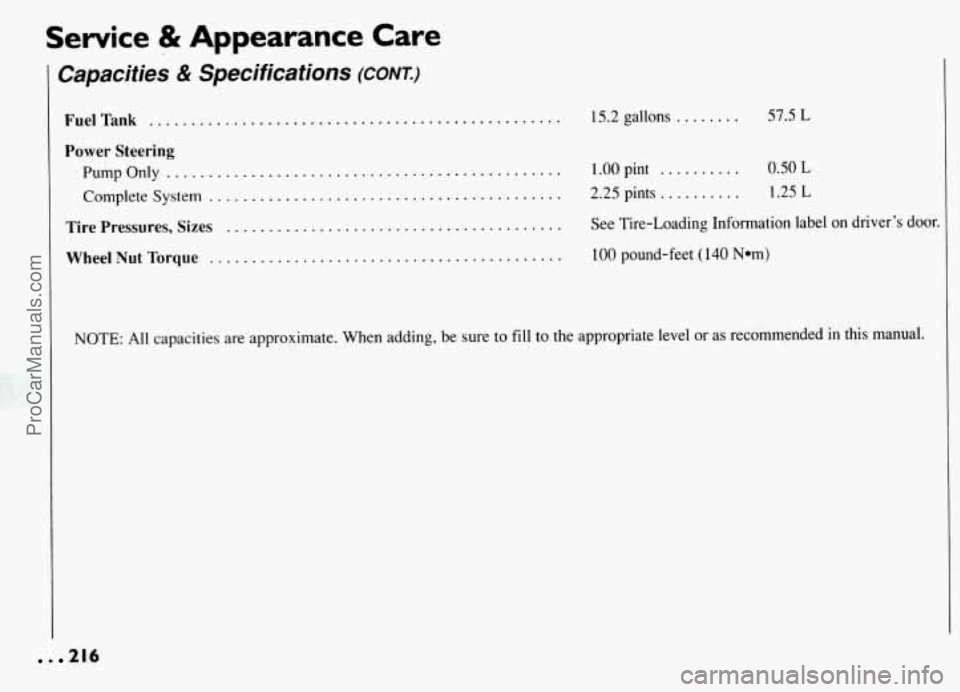
Service & Appearance Care
Capacities & Specifications (CONT.)
Complete System . .
Tire Pressures, Sizes
Wheel
Nut Torque . .
FuelTank .................................................
Power Steering
PumpOnly ...............................................
......................................
........................................
........................................
15.2 gallons ........ 57.5 L
1.00 pint .......... 0.50 L
2.25 pints .......... 1.25 L
See Tire-Loading Information label on driver’s door.
100 pound-feet ( 140 N*m)
NOTE: All capacities are approximate. When adding, be sure to fill to the appropriate level or as recommended in this manual.
. 216
ProCarManuals.com
Page 231 of 274
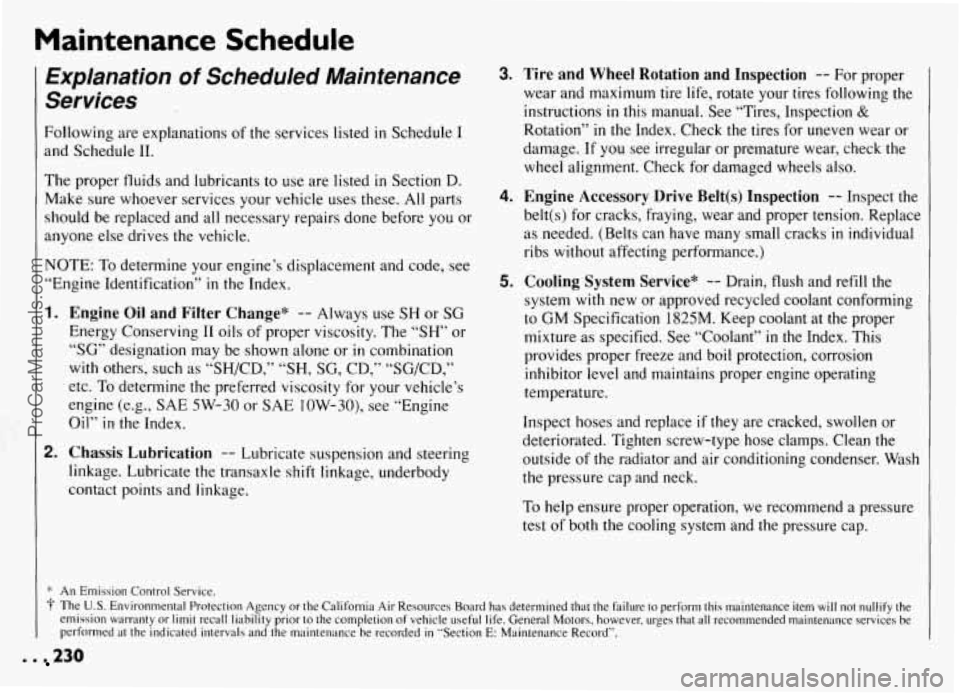
Maintenance Schedule
Explanation of Scheduled Maintenance
Services
Following are explanations of the services listed in Schedule I
and Schedule 11.
The proper fluids and lubricants to use are listed in Section D.
Make sure whoever services your vehicle uses these. All parts
should be replaced and all necessary repairs done before you or
anyone else drives the vehicle.
NOTE: To determine your engine’s displacement and code, see
“Engine Identification”
in the Index.
1.
2.
Engine Oil and Filter Change* -- Always use SH or SG
Energy Conserving I1 oils of proper viscosity. The “SH” or
“SG” designation may be shown alone or in combination
with others, such as “SH/CD,” “SH, SG, CD,” “SG/CD,”
etc. To determine the preferred viscosity for your vehicle’s
engine (e.g., SAE 5W-30 or SAE 10W-30), see “Engine
Oil”
in the Index.
Chassis Lubrication -- Lubricate suspension and steering
linkage. Lubricate the transaxle shift linkage, underbody
contact points and linkage.
3.
4.
5.
Tire and Wheel Rotation and Inspection -- For proper
wear and maximum tire life, rotate your tires following the
instructions
in this manual. See “Tires, Inspection &
Rotation” in the Index. Check the tires for uneven wear or
damage. If you see irregular or premature wear, check the
wheel alignment, Check for damaged wheels also.
Engine Accessory Drive Belt(s) Inspection -- Inspect the
belt(s) for cracks, fraying, wear and proper tension. Replace
as needed. (Belts can have many small cracks
in individual
ribs without affecting performance.)
Cooling System Service* -- Drain, flush and refill the
system with new or approved recycled coolant conforming
to
GM Specification 1825M. Keep coolant at the proper
mixture as specified. See “Coolant”
in the Index. This
provides proper freeze and boil protection, corrosion
inhibitor level and maintains proper engine operating
temperature.
Inspect hoses and replace if they are cracked, swollen or
deteriorated. Tighten screw-type hose clamps. Clean the
outside of the radiator and air conditioning condenser. Wash
the pressure cap and neck.
To help ensure proper operation, we recommend a pressure
test of both the cooling system and the pressure cap.
. . 230
ProCarManuals.com
Page 234 of 274
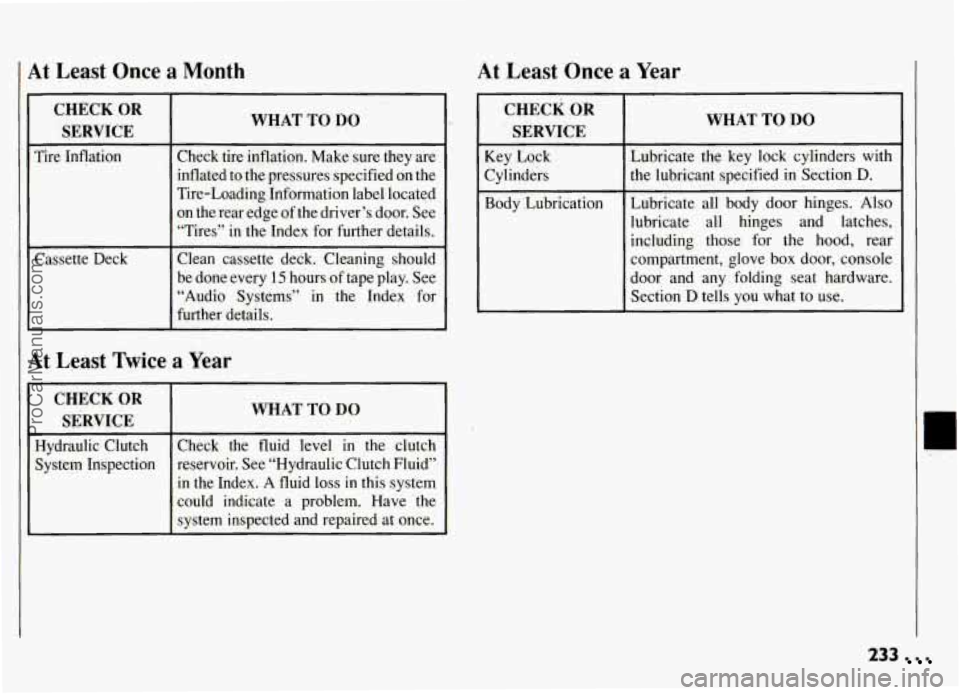
At Least Once a Month At Least Once a Year
WHAT TO DO I’
Tire Inflation Check tire inflation. Make sure they are
inflated to the pressures specified on the
Tire-Loading Information label located
on the rear edge of the driver’s door. See
“Tires” in the Index for further details.
Cassette Deck Clean cassette deck. Cleaning should
be done every
15 hours of tape play. See
“Audio Systems” in the Index for
further details.
I I
Lt Least Twice a Year
SERVICE I
WHAT TO DO
Hydraulic Clutch Check the fluid level in the clutch-
System Inspection reservoir. See “Hydraulic Clutch Fluid”
in the Index.
A fluid loss in this system
could indicate a problem. Have ‘the
system inspected and repaired at once.
CHECK OR
SERVICE
Key Lock
Cylinders
Body ‘Lubrication
WHAT TO DO
Lubricate the key lock cylinders with
the lubricant specified in Section
D.
Lubricate all body door hinges. Also
lubricate all hinges and latches,
including those for the hood, rear
compartment, glove box door, console
door and any folding seat hardware.
Section
D tells you what to use.
I
233
ProCarManuals.com
Page 266 of 274

Highway Hypnosis ........... 134
.Hill and Mountain ............ 134
In a Foreign Country
.......... 172
In the Rain
.................. 13C
Logg Distance ............... 132
Loss of Control
.............. 128
On Curves
.................. 125
Passing
.................... 127
Skidding
................... 128
Through Deep Standing Water
... 58
Winter Driving .............. 136
With a Trailer
............... 144
Driving.on Snow or Ice .......... 136
Drunken Driving
............... 120
Easy-Entry Seat ................ 11
Electrical Equipment. Adding
. 107. 2 1 1
Emergencies. Braking .. .. ........ 125
Emergencies on the Road
......... 147
Emergencies. Steering
in ......... 126
Emergency Starting
.. i .......... 148
Emergency Towing
............. 152
Engine Coolant Heater (Engine Block Heater)
....... : ..... 58. 182
Engine Coolant Temperature
Warning Light ................. 94
Engine Identification
............ 2 11
Engine Oil
.................... 179
Additives ................... 182
Checking
& Adding .......... 179
Disposing of Used Oil
........ 182
Engine Coolant (see “Coolant”) .... 188
Energy Conserving ........... 18 I
Filter .................. 182. 22C
Kind of Oil to Use
............ 18C
Pressure- Gage ................ 9f
Warning Light
................ 95
When to Change ............. 182
Engine Overheating ............. 156
Engine Specifications
............ 2 19
Engine. Starting
................. 56
Automatic Transaxle ........... 56
Manual Transaxle ............. 56
2.3L Quad 4 Engine
........... 56
3.lL V6 Engine ............... 57
Ethanol in Gasoline ......... 17 1. 172
Exhaust
Dangerous Gas in
......... 70. 138
Pirking with the Engine
Running ................ 67. 69
Expectant Mothers. Use of Safety
Belts ......................... 26
Expressway Driving
............. 132
Extender. Safety Belt
............. 42
Exterior Appearance (see “Appearance
Care”) ....................... 204
Fabric Cleaning (see “Appearance
Care”) ...................... 204
Filling the Fuel Tank
........ 174. 2 16
Filter. Oil
................ 182. 220
Finish Damage
................. 209
Flashers. Hazard Warning
........ 148
Flat Tire
...................... 161
Flooded Engine ................. 57
Flow-Through Ventilation System . . 105
Fluid
‘Brake ...................... 192
Capacities
.................. 215
Hydraulic Clutch
............. 187
Power Steering
.......... 190. 216
Transaxle
Automatic ........... 184. 215
Manual
.............. 186. 215
Windshield Washer
........... 191
Fluids
& Lubricants ............. 238
Fog Lights
................. 79. 196
Freeway Driving
............... 132
French Language Manual
.......... 2
Fuel
......................... 171
Alcohol
in Fuel .......... 17 1. 172
Capacity
................... 216
Exhaust Warnings
......... ..70. 138
Filling Your Tank
......... 1 .. 174
Fuels
with Alcohol ....... !7 1. 172
Gage
........................ 93
In Foreign Countries .......... 173
Remote Fuel Filler Door
........ 53
Requirements
............... 171
Fuse Usage Chart ............... 213
Fuses
& Circuit Breakers ......... 212
Gages
Coolant Temperature .......... 94
Fuel ........................ 93
Oil Pressure .................. 96
265
E
ProCarManuals.com
Page 270 of 274

Stereo Sound Systems (see “Audio
Storage
Systems”) ................... lot
Armrest ..................... 82
Glove Box ................... 54
Passenger Side Cup Holder/
Storage Area ................ 85
Sunglasses Storage ............ 87
Storing Your Pontiac ............ 194
Stuck. If You Are
............... 167
Subscriptions .................. 25C
Sun Visors
..................... 84
Supplemental Restraint System (SRS)
........................ 21
Surge Tank Pressure Cap
......... 190
Tachometer .................... 92
rape Player (see “Audio Systems”)
rechnical Facts
& Specifications
Bulbs ...................... 217
Electrical Equipment.
Add-on .............. 107. 2 1 1
Fluid Capacities & Types . . 215. 216
Fuses
& Circuit Breakers ...... 212
Service Parts Edentification
Label ..................... 211
Vehicle Identification
Number (VIN) ............. 2 11
remperature Warning Light
........ 94
rheft
.......................... 52
rhermostat
.................... 190
l‘ilt Steering Wheel
.............. 71
Time. Setting the ............... 107
Tires
......................... 198
Buying New ................ 201
Chains
................. 143. 202
Flat. Changing
............... 162
Inflation
.................... 199
Inspection
& Rotation ......... 200
Loading
.................... 198
Pressure
.................... 199
Quality Grading
............. 201
Spare. Compact
.............. 167
Wear Indicators
.............. 192
Wheel Alignment and
Tire Balance ............... 202
Wheel Replacement
.......... 202
When to Replace Wheels
...... 202
Winter Driving. and Tires
...... 136
Top Strap ...................... 33
Torque Lock
.................... 68
Towing a Trailer
................ 141
Towing Your Pontiac
............ 152
Trailer Towing
................. 139
Maintenance ................ 146
Parking on Hills
............. 145
Trailer Brakes
............... 143
Driving with a Trailer ......... 144
Transaxle. Automatic (see “Automatic
Transaxle. Manual (see “Manual
rransmission. Automatic (see
Transaxle”)
Transaxle”)
“Automatic Transaxle”)
Transmission. Manual (see “Manual
Trip Odometer .................. 92
Trunk
......................... 53
Trunk Light
.................... 80
Trunk Release. Remote ........... 53
Turn Signal Indicator
............. 73
Turn Signal/Multifunction Lever
.... 78
Cruise Control ................ 74
Headlight Highbow Beam
...... 78
Turn Signal & Lane Change
Indicator ................... 73
Underbody Maintenance ........ 209
Unleaded Gasoline
.............. 173
Upholstery Care
................ 205
Upshift Indicator Light
......... 65. 99
Urban Driving
................. 132
Variable Effort Steering ......... 125
Vehicle “Break-In” Period
......... 54
Vehicle. Control
of a ............ 122
Vehicle Identification Number
(VIN) ....................... 211
Vehicle Loading
................ 197
Vehicle Storage
................ 194
Ventilation (see “Comfort
Controls”) ................... 103
VIN
......................... 211
Visors. Sun
..................... 84
Visor Vanity Mirror
.............. 84
Voltmeter ...................... 97
269
Transaxle” )
d
ProCarManuals.com
Page 273 of 274
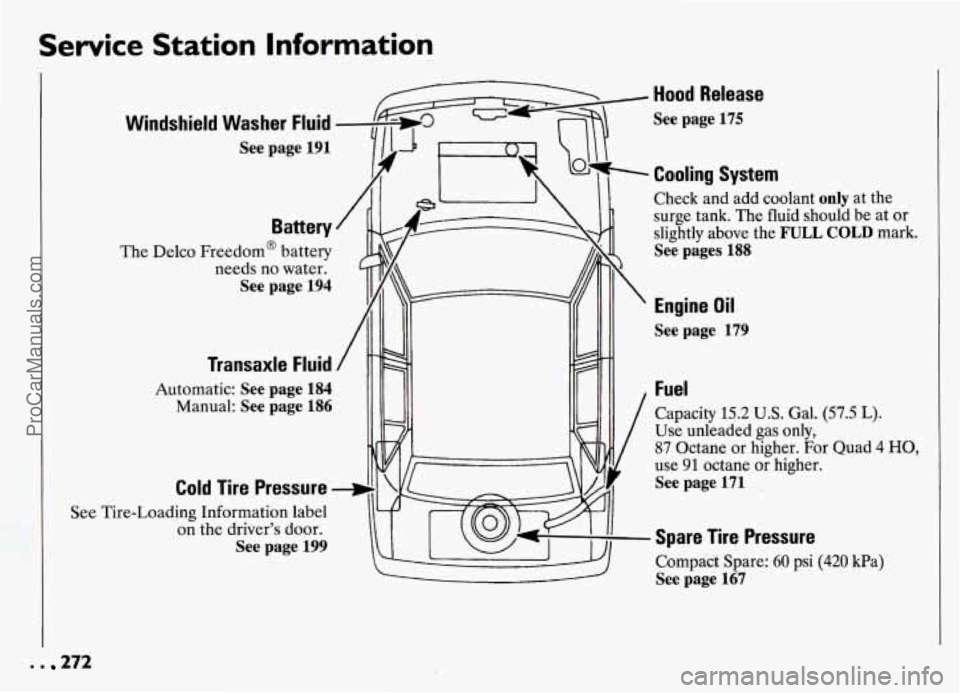
Service Station Information
See
7
Windshield Washer Fluid
Battery
The Delco Freedom@ battery
needs no water.
See page 194
Transaxle Fluid
Automatic: See page 184
Manual: See page 186
Cold Tire Pressure
Tire-Loading Information label
on the driver's door.
Seepage199
- Hood Release
See page 175
- Cooling System
Check and add coolant only at the
surge tank. The fluid should be at
or
slightly above the FULL COLD mark.
See pages 188
Engine Oil
See page 179
Capacity 15.2 U.S. Gal. (57.5 L).
Use unleaded gas only,
87 Octane or higher. For Quad 4 HO,
use 91 octane or higher.
See page 171 .
- Spare Tire Pressure
Compact Spare: 60 psi (420 kPa)
See page 167
. . 272
ProCarManuals.com